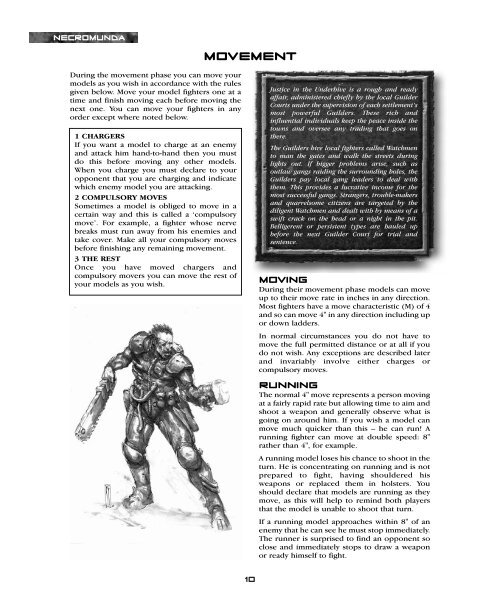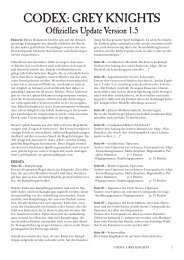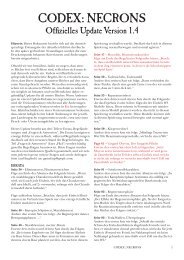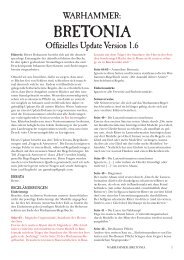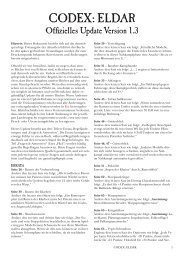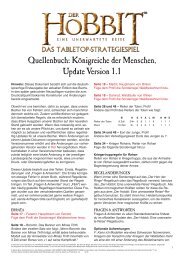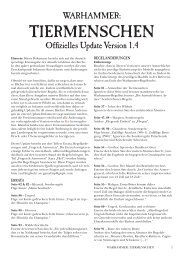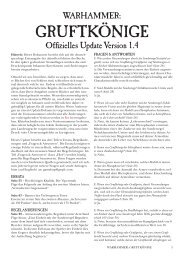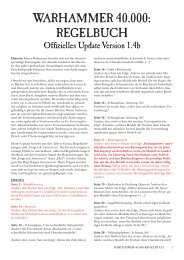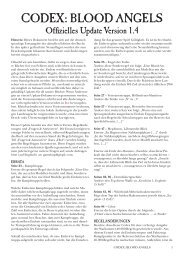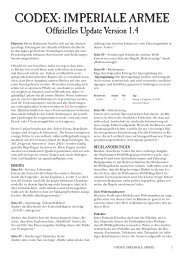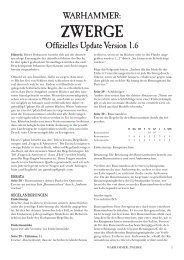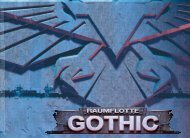Necromunda rulebook - Games Workshop
Necromunda rulebook - Games Workshop
Necromunda rulebook - Games Workshop
You also want an ePaper? Increase the reach of your titles
YUMPU automatically turns print PDFs into web optimized ePapers that Google loves.
NECROMUNDA<br />
During the movement phase you can move your<br />
models as you wish in accordance with the rules<br />
given below. Move your model fighters one at a<br />
time and finish moving each before moving the<br />
next one. You can move your fighters in any<br />
order except where noted below.<br />
1 CHARGERS<br />
If you want a model to charge at an enemy<br />
and attack him hand-to-hand then you must<br />
do this before moving any other models.<br />
When you charge you must declare to your<br />
opponent that you are charging and indicate<br />
which enemy model you are attacking.<br />
2 COMPULSORY MOVES<br />
Sometimes a model is obliged to move in a<br />
certain way and this is called a ‘compulsory<br />
move’. For example, a fighter whose nerve<br />
breaks must run away from his enemies and<br />
take cover. Make all your compulsory moves<br />
before finishing any remaining movement.<br />
3 THE REST<br />
Once you have moved chargers and<br />
compulsory movers you can move the rest of<br />
your models as you wish.<br />
MOVEMENT<br />
10<br />
Justice in the Underhive is a rough and ready<br />
affair, administered chiefly by the local Guilder<br />
Courts under the supervision of each settlement’s<br />
most powerful Guilders. These rich and<br />
influential individuals keep the peace inside the<br />
towns and oversee any trading that goes on<br />
there.<br />
The Guilders hire local fighters called Watchmen<br />
to man the gates and walk the streets during<br />
lights out. If bigger problems arise, such as<br />
outlaw gangs raiding the surrounding holes, the<br />
Guilders pay local gang leaders to deal with<br />
them. This provides a lucrative income for the<br />
most successful gangs. Strangers, trouble-makers<br />
and quarrelsome citizens are targeted by the<br />
diligent Watchmen and dealt with by means of a<br />
swift crack on the head or a night in the pit.<br />
Belligerent or persistent types are hauled up<br />
before the next Guilder Court for trial and<br />
sentence.<br />
MOVING<br />
During their movement phase models can move<br />
up to their move rate in inches in any direction.<br />
Most fighters have a move characteristic (M) of 4<br />
and so can move 4" in any direction including up<br />
or down ladders.<br />
In normal circumstances you do not have to<br />
move the full permitted distance or at all if you<br />
do not wish. Any exceptions are described later<br />
and invariably involve either charges or<br />
compulsory moves.<br />
RUNNING<br />
The normal 4" move represents a person moving<br />
at a fairly rapid rate but allowing time to aim and<br />
shoot a weapon and generally observe what is<br />
going on around him. If you wish a model can<br />
move much quicker than this – he can run! A<br />
running fighter can move at double speed: 8"<br />
rather than 4", for example.<br />
A running model loses his chance to shoot in the<br />
turn. He is concentrating on running and is not<br />
prepared to fight, having shouldered his<br />
weapons or replaced them in holsters. You<br />
should declare that models are running as they<br />
move, as this will help to remind both players<br />
that the model is unable to shoot that turn.<br />
If a running model approaches within 8" of an<br />
enemy that he can see he must stop immediately.<br />
The runner is surprised to find an opponent so<br />
close and immediately stops to draw a weapon<br />
or ready himself to fight.


